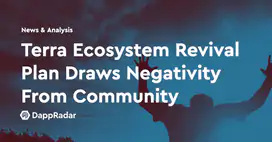Terra CEO Do Kwon has taken to Twitter to announce an ecosystem revival plan based on forking the blockchain, which has drawn negative attention from the community. The fork has become the main effort by Terra Labs to repair the immense damage caused to its operations and brand.
On May 16, Do Kwon took to Twitter to announce that ‘Terra is more than UST’ in a long thread where he outlines plans to fork the Terra blockchain as it currently exists but without algorithmic stablecoins. The new fork would be called Terra, and its token would be LUNA, and the old chain would then be called Terra Classic and have the LUNC token. Both chains will coexist.


Last week, the Terra blockchain ecosystem deteriorated in a matter of days. Its native token LUNA, which had over $40 billion in market capitalization, saw nearly all of its value wiped out. Meanwhile, UST, which was supposed to be a stablecoin pegged to the US dollar, crashed.
Terra LUNA launched and listed on Binance in August 2020, opening at $0.53 before reaching an all-time high in April 2022 of $119.55. It then lost over 99% of its value in a crash being likened to the Bitconnect tale or by some to the Theranos scam conducted by Elizabeth Holmes.
LUNA Classic
The aftermath of the tragic events that unfolded over the last week has left Terra and its ecosystem in complete disarray. On May 16, Do Kwon took to Twitter to announce that ‘Terra is more than UST’ in a long thread where he outlines plans to fork the Terra blockchain as it currently exists but without algorithmic stablecoins.
Summary of the proposal
- Fork the Terra chain into a new chain without the algorithmic stablecoin. The old chain to be called Terra Classic (token Luna Classic – LUNC), and the new chain to be called Terra (token Luna – LUNA)
- Luna to be airdropped across Luna Classic stakers, Luna Classic holders, residual UST holders, and essential app developers of Terra Classic.
- TFL’s wallet (terra1dp0taj85ruc299rkdvzp4z5pfg6z6swaed74e6) will be removed from the whitelist for the airdrop, making Terra a fully community-owned chain
- Allocate a large portion of the token distribution to 1) provide an emergency runway for existing Terra dapp developers and 2) align the interest of devs with the long term success of the ecosystem
- Network security to be incentivized with token inflation. Target staking rewards of 7% p.a.
The new fork would be called Terra, and its token would be LUNA, and the old chain would then be called Terra Classic and have the LUNC token. Similarly, both chains will coexist in a move that reminds this writer of the Ethereum Classic debate. The LUNA Foundation Guard has also reportedly spent most of its bitcoin reserves to stabilize UST and restore its peg. At writing, UST trades at $0.09.
The proposal has received mixed responses from the community, some see it as a possible and perhaps only solution, while others are not very happy at all, and point at a lack of transparency and communication from Terra as the saga unfolded.




Blockchain rallies
Amid the collapse of Terra, other blockchains, including Polygon, Juno, and Fantom, are trying to attract Terra-based dapp projects over to their networks. Ryan Wyatt, CEO of Polygon Studios, the NFT, gaming, and metaverse arm of Polygon, tweeted that his team was closely collaborating with Terra projects to help them migrate to the Polygon network.


Other blockchains are trying to appeal to developers building dapps on Terra. Juno, an interoperability-focused smart contract network, introduced a new governance proposal asking for approval for incentives of up to 1 million JUNO, or around $7 million, to support Terra projects who want to move their dapps. Juno’s blockchain shares similarities with Terra’s technical architecture as they rely on the Cosmos SDK. Likewise, the Fantom blockchain also tweeted that it offers grants, marketing, and ecosystem connections to Terra projects looking for a new blockchain.
The move feels like a positive one as companies seemingly come to the rescue of the hard-working dev teams affected. However, the more skeptical of us may see the vultures circling and looking to extract the best parts from the Terra ecosystem and leave behind a rotting corpse. Perhaps two rotting corpses if the fork goes ahead and things don’t go as planned.
User error?
The industry has been up in arms all week; some shout Ponzi, while others scream deception. However, respected industry commentator and CEO of the FTX exchange Sam Bankman-Fried says that the downfall of Ethereum challenger Terra was due to inaccurate marketing rather than outright deception.
In a series of tweets, Sam Bankman-Fried says that it’s unfair to compare the collapse of LUNA and its stablecoin TerraUSD to the breakdown of Theranos or BitConnect. He further stated that Do Kwon did not deceive investors but admitted that the CEO could have done a much better job of making investors aware that US dollars didn’t fully back UST.


The critical point for Bankman-Fried is that Do Kwon didn’t claim that UST was backed 1:1 by USD. He claimed, correctly, that a group of volatile crypto assets supported it. It was
publicly clear that those assets might go down, and the rest would follow. In a nutshell, LUNA was a case of enthusiasm, excitement, marketing, and memes pushing people to believe in something that would inevitably falter according to the publicly available information.
Stability remains
Last week, there was fear that other leading US dollar-backed stablecoins would falter as investors became miffed and started withdrawing large amounts of stablecoin capital in case of a similar situation. Last week we reported that the leading stablecoins had deviated slightly from their pegs, BUSB by as much as $0.05, but we see that the leaders have regained control of their algorithmic pegs at writing.


The debacle reminds hungry investors that things can turn negative as fast as they turn positive. Moreover, it will be interesting to see if Terra or Do Kwon have any plans to make those investors that lost everything whole again. While it’s doubtful, such a move would speak volumes about Terra and its commitment to its users. Similarly, Yuga Labs refunded failed gas transactions to those that tried and failed to buy Otherside NFT lands a few weeks ago, costing them more than $6 million. The actions of Yuga and BAYC indicate that they want to be around for a long time and not just have a good time. What Terra wants is still very unclear.
The above does not constitute investment advice. The information given here is purely for informational purposes only. Please exercise due diligence and do your research. The writer holds positions in various cryptocurrencies, including BTC, ETH, and RADAR.




